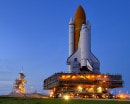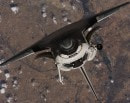Number of missions: 39. Miles traveled: 148 million (238.2 million km). Number of times around the world: 5,830. Total time spent in space in its 27 years of active duty: one year.
These are the figures that make up the activity of space shuttle Discovery, a man-made vehicle intended to take astronauts and materials into space, but also return to the ground to fly again later. Discovery was not the first space shuttle, or orbiter, as NASA calls the vehicles, to have ever been created. It is, however, the first to have landed, successfully, for the last time, the first to be retired from service, with honors.
The final landing of the Discovery, which took place on March 9, 2011, marks the beginning of the end for the American space shuttle program. The two remaining orbiters, the Atlantis and the Endeavor, will follow in its tire marks after they would have flown their final missions later this year.
For most, Discovery, as did all space shuttles, represented nothing more than a feat worth mentioning on page four of some regional newspaper. The repeated successful launches and landings have made the shuttles as plain as the tornadoes of Tornado Alley. From time to time, the occasional disaster, like the Columbia one in 2003, brought back the shuttles into the public eye, but only briefly.
For others, the hardcore few, Discovery, as did the entire fleet of orbiters, represented a way of life. Some have worked for NASA's shuttle program for decades, while others have been completely mesmerized by the space travel possibilities the shuttles presented them with. For all, we thought to bring you a little more details about the vehicle that has taken humans into space, repeatedly, and brought them safely back to Earth.
BIRTH OF THE SHUTTLE PROGRAM
As the cold war space race was pushing the world's major superpowers into an insane rush to become the first to land a man on the Moon, the American Space Agency was looking to cut cost.
The space crafts of the time, most merely capsules strapped to huge rockets, had the major disadvantage of being both very expensive and, for most of the time, a one shot deal. Meaning you launched it, it came back down, and that was it. They had to build another. Other designs, reusable in nature, were insanely complicated from the mechanical view and at times prohibitively expensive.
Encouraged by President Nixon's Space Task Group, the agency began looking into ways to cut those costs. Not long, NASA realized that in order to be cheaper, and easier to use, the future space craft would have to be reusable. This was the idea that gave birth to the space shuttle program, a program NASA likes to call the Space Transportation System (STS), on January 5, 1972
As said, the Discovery was not the first space shuttle developed under the STS program. The first, which was only used for testing, was the Enterprise (named like that because of the Star Trek fans who flooded the government with letters asking for the Enterprise name to be used instead of the Constitution one).
Following the successful testing of the Enterprise, the first orbiter ready for duty arrived as the Columbia (OV-102). The Columbia was the first shuttle to be launched into space, during the STS-1 mission on April 12, 1981. The Columbia ended its career burning, together with the seven-member crew, at re-entry, on February 1, 2003.
The second functioning space shuttle to be ever built, the Challenger, was launched for the first time April 4, 1983, during the STS-6 mission. On January 28, 1986, Challenger was destroyed soon after take off due to the failure of an O-ring on its right solid-fuel rocket booster (SRB). It also took seven people down with it, including the first teacher in space, Christa McAuliffe.
The third shuttle, Discovery (we'll talk about it below) was followed by Atlantis in April 1985, a shuttle that will be retired later this year. The fifth one, Endeavor, was built to replace Challenger and will also be retired later this year.
The space crafts of the time, most merely capsules strapped to huge rockets, had the major disadvantage of being both very expensive and, for most of the time, a one shot deal. Meaning you launched it, it came back down, and that was it. They had to build another. Other designs, reusable in nature, were insanely complicated from the mechanical view and at times prohibitively expensive.
Encouraged by President Nixon's Space Task Group, the agency began looking into ways to cut those costs. Not long, NASA realized that in order to be cheaper, and easier to use, the future space craft would have to be reusable. This was the idea that gave birth to the space shuttle program, a program NASA likes to call the Space Transportation System (STS), on January 5, 1972
As said, the Discovery was not the first space shuttle developed under the STS program. The first, which was only used for testing, was the Enterprise (named like that because of the Star Trek fans who flooded the government with letters asking for the Enterprise name to be used instead of the Constitution one).
Following the successful testing of the Enterprise, the first orbiter ready for duty arrived as the Columbia (OV-102). The Columbia was the first shuttle to be launched into space, during the STS-1 mission on April 12, 1981. The Columbia ended its career burning, together with the seven-member crew, at re-entry, on February 1, 2003.
The second functioning space shuttle to be ever built, the Challenger, was launched for the first time April 4, 1983, during the STS-6 mission. On January 28, 1986, Challenger was destroyed soon after take off due to the failure of an O-ring on its right solid-fuel rocket booster (SRB). It also took seven people down with it, including the first teacher in space, Christa McAuliffe.
The third shuttle, Discovery (we'll talk about it below) was followed by Atlantis in April 1985, a shuttle that will be retired later this year. The fifth one, Endeavor, was built to replace Challenger and will also be retired later this year.













